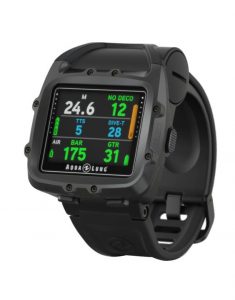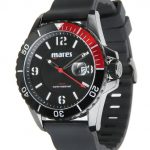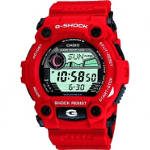Watches
It’s a good idea to wear a water-resistant watch while snorkelling, as it's helpful to know how long you've been swimming. In cold water, it will remind you to keep an eye out for cramp (we usually start looking out for it after twenty minutes at 18 degrees, though everyone is different). If it's hot, you will have an idea of how long the sun has been beating down on your back. Whatever, it's another way of controlling things when you're out in the water.
What kind of watch should you get?
Short answer: Buy a watch that is water-resistant to 20 ATM, that has large numbers so you can see it in murky water, and a bezel that you set manually to the minute hand that will show you how many minutes have elapsed. Luminescence is optional but also a good idea.


Above: a dive computer. You don't need one of these.
Below: snorkelling watches. They cost about £100 each. You could try simply scuba https://www.simplyscuba.com/pages/search-results-page?q=watches
or watersports warehouse https://www.watersportswarehouse.co.uk/shop/snorkeling/watches-for-diving.html
Actually, that's still a lot of money. probably more than you need to spend. Look around..


Long answer: Working out atmospheric pressure is a complex thing, but generally it is agreed that the air pressure on earth at sea level is 1 Atmosphere (ATM). If you climb a mountain, the air gets thinner and is less than 1ATM, and if you dive under the sea, the water pressure is denser than air pressure. If you dive just over 10 metres, you get to another 1 Atmosphere. A diver at 10 metres below the surface has one Atmosphere of water plus one Atmosphere of air, or 2 Atmospheres of pressure: so a snorkeller can buy a watch with 2 ATM on it and everything will be fine, right? Er, no.
The term ‘waterproof’ isn't used any more, as it implies that the watch will repel water under all circumstances. That isn't necessarily true. The term used is ‘water resistant’. And ATMs don't just measure depth: they measure pressure. If you’re swimming, and plunging your arm into water, you're exerting pressure on your watch - sometimes quite a lot of pressure. A lot more than 1 or 2 Atmospheres. So if you buy a watch that is water resistant to 2 Atmospheres, and you move while you're getting to the 10 metre depth, you're exerting a lot more than 2 Atmospheres of pressure on your watch. It will leak.
This website gives a really helpful explanation:
https://bigwatchworld.com/water-resistance/5atm-50m-165ft
They say, 3ATM, not suitable for swimming, 5ATM, ok for swimming, 10ATM, ok for snorkelling, 20ATM, ok for scuba diving. So you could get a 10ATM watch if you like: we’re just a little conservative about this.
Some watches are rated by metres - 200 M means it will work down to 200 metres, or 20 ATM. Open Water Divers - the first level of scuba diver - are licensed to 18 metres. 200 should be ok for you. At a minimum, go for 100M.
A couple of other things they point out: first, don't wear your watch in a hot bath or shower. The seals won't be able to cope. Second, remember to tighten the watch screw before you go in the water (if it has one) or the watch might leak.
You’ll probably have to send your watch away when it needs a new battery, as the seals have to be checked and replaced when you change the battery, or every two years.

Usual warning: we have made every effort to make sure this information is correct and up-to-date, but you need to check it all yourself.
© Garreg Lwyd Ltd 2018
